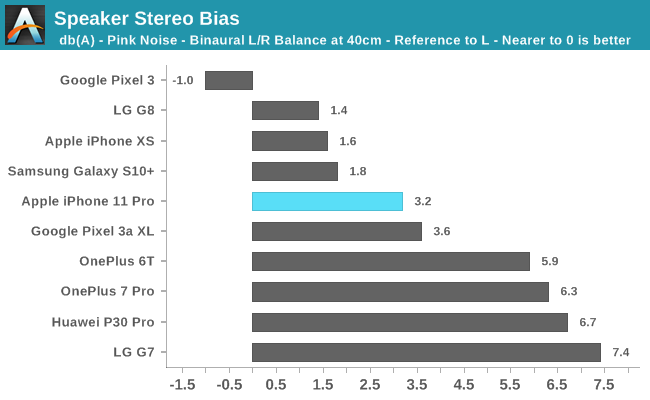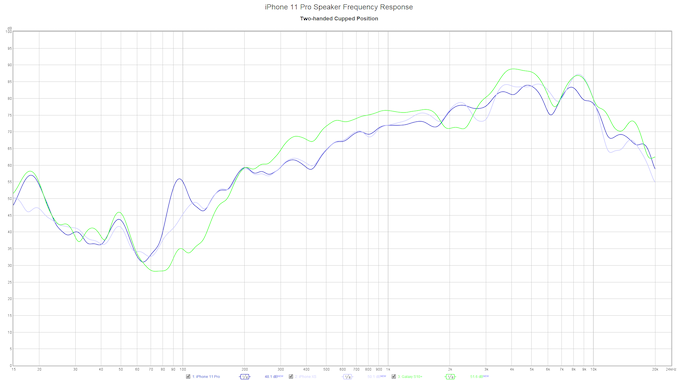The Apple iPhone 11, 11 Pro & 11 Pro Max Review: Performance, Battery, & Camera Elevated
by Andrei Frumusanu on October 16, 2019 8:30 AM ESTVideo Recording
Video recording on the iPhone is known to be extraordinarily good in terms of quality. The iPhone 11 series is said to improve in this regard thanks to an improved HDR with more dynamic range (though Apple still stores video in SDR format). Naturally of course what’s also exciting is that we’re now able to capture video with a wide-angle lens, and seeing a lot more content of a given scene.
Apple has improved the EIS this generation, and it now results in a much smoother video capture experience than the past iterations. When you have with a lot of detail in a scene though, you can sometimes see the jitter caused by the OIS and EIS interacting with each other.
In the wide-angle recording, the EIS was a bit haphazard. In the first part of the video walking down the path it doesn’t look to be stabilizing much at all, when I turn left to the second path suddenly the EIS kicked in and things were a lot less shaky, and it then again loses the stabilization for few steps until it finally resumes again. This happened all three recordings with the wide-angle camera, and I don’t know it was me holding the phone any different between those two paths.
The quality and detail of the videos are all great. The one thing noticed though is that there’s the occasional exposure flicker in some areas. In effect Apple here is doing two exposures per frame and combining them together like Smart HDR – we can notice that in parts of the scene, and most visible the sky is flickering or pulsing in brightness.
The handling between the three camera sensors is very good, it’s particularly fast and seamless to switch between the main and wide-angle modules, while there’s a small delay to switch to the telephoto module. Switching between the three modules is only possible in 30fps recording modes; it’s still possible to record 60fps in any of the three modules but you have to start out the video with the camera that you want to use, and you’ll be limited to digital zooming only while recording.
Speaker Evaluation
In terms of audio for the iPhone 11 series, Apple’s big addition is the inclusion of Dolby Atmos. Naturally you have to watch multi-channel audio content to be able to take advantage of the feature. For regular stereo audio playback, we investigate if Apple has done any changes to the speaker setup and if it differs to that of the XS.

In terms of audio volume, the iPhone 11 Pro is ever so slightly quieter when being held in portrait mode. The bigger difference that’s definitely more audible is when holding the phone in landscape mode with both hands and the palms cupped – the usual way one would hold a phone in landscape. Here it’s 3dB quieter than the iPhone XS, which is a noticeable amount.

Investigating the phone’s stereo bias thanks to a binaural microphone setup, we see that that things have notably regressed for the iPhone 11 Pro when compared to the XS. It’s relatively normal for the main speaker (Right side) to appear louder, however it’s extremely weird that it’s now 1.6dB more biased than on the iPhone XS. Indeed when comparing the 11 Pro and XS side-by-side, and muting the main speaker by holding a finger on it, volume being equal and otherwise calibrated between the two phones, it’s immediately audible that the 11 Pro earpiece speaker is much quieter compared to what we experience on the XS.
This has a rather large knock-on effect on the spatial sound reproduction of the 11 Pro as it just isn’t able to fill up the surrounding area quite as well as on the XS.
Looking at the frequency response between the 11 Pro and the XS, we see that things are extremely similar up to the high mid-ranges, with a more noticeable peak at 95Hz for the 11 Pro. Towards the treble we see some more deviations, it’s here that the 11 Pro is a bit quieter and I think that’s due to the weaker earpiece speaker.
Overall, the sound signature of the iPhone 11 Pro hasn’t changed all too much, and it is actually more of a downgrade in audio playback due to the weaker earpiece speaker calibration. The Galaxy S10’s notably stronger lower mid-range and mid-range still make for a much superior audio playback and is in my experience the device to beat in terms of speaker quality.











242 Comments
View All Comments
Henk Poley - Saturday, October 19, 2019 - link
Does the A13 have more security features, such as the pointer encryption that was added with the A12 (essentially binding pointers to their origin (e.g. processes)) ? It was kinda interesting that the recent mass exploitation of iPhones uncovered, didn't touch any of the A12 iDevices (and neither does jailbreaks).techsorz - Sunday, October 20, 2019 - link
I'm sorry Anandtech, but your GPU review is absolutely horrendous. You are using 3Dmark on iOS, which hasn't recieved an update since IOS 10 and then compare it to the Android version which was updated June 2019. There is a reason you are getting conflicted results when you switch over to GFXbench, which was updated on iOS in 2018. How this didn't make you wonder, is amazing.Andrei Frumusanu - Sunday, October 20, 2019 - link
The 3D workloads do not get updated between the update versions, so your whole logic is moot.techsorz - Sunday, October 20, 2019 - link
Are you kidding me? The load won't change, but the score sure will. It makes it look like the iPhone throttles much more than it does in reality. That the score is 50% less due to unoptimized garbage does not mean that the chipset actually throttled with 50%.I can't believe that I have to explain this to you, 3Dmark supports an operative system that is 3 years old, for all we know it is running in compatibility mode and is emulated.
Andrei Frumusanu - Sunday, October 20, 2019 - link
Explain to me how the score will change if the workload doesn't change? That makes absolutely zero sense.You're just spouting gibberish with stuff as compatibility mode or emulation as those things don't even exist - the workload is running on Metal and the iOS version is irrelevant in that regard.
techsorz - Monday, October 21, 2019 - link
In computing you have what is called a low-level 3D API. This is what Metal and DirectX is. This is what controls how efficiently you use the hardware you have available. If you have a new version of this API in say, IOS 13, and you run an iOS 10 application, you will run into compatibility issues. These issues can degrade performance without it being proportional to the actual throttling taking place. On android however, it is compatible with the latest low-level API's as well as various performance modes.The hillarious thing is that Anandtech even contradict themselves, using an "only" 1 year outdated benchmark, where the iPhone suddenly throttles less at full load. This entire article is just a box full of fail, if you want to educate yourself, I suggest you watch Speedtest G on Youtube. Or Gary Explains. He has a video on both 'REAL' iOS and Android throttling, done using the latest version of their respective API
Andrei Frumusanu - Monday, October 21, 2019 - link
> If you have a new version of this API in say, IOS 13, and you run an iOS 10 application, you will run into compatibility issues. These issues can degrade performance without it being proportional to the actual throttling taking place. On android however, it is compatible with the latest low-level API's as well as various performance modes.Complete and utter nonsense. You literally have no idea what you're talking about.
techsorz - Monday, October 21, 2019 - link
How about you provide a proper response instead of saying it's nonsense. How can the throttling be different at full load on 2 different benchmarks otherwhise? There is clearly no connection between actual throttling and the score itself. You are literally contradicting yourself in your own review.Andrei Frumusanu - Monday, October 21, 2019 - link
A proper response to what exactly? Until now all you managed to do is complain is that the test is somehow broken and wrong and I need to educate myself.The whole thing has absolutely nothing to do with software versions or OS version or whatever other thing. The peak and sustained scores are performed with the same workloads and nothing other than the phone's temperature has changed - the % throttling is a physical attribute of the phone, the benchmark doesn't decide to suddenly throttle more on one benchmark more than the other simply because it's somehow been released a few years ago.
The throttling is different on the different tests *because they are different workloads*. 3DMark and Aztec High will put very high stress the ALUs on the GPU, more than the other tests and create more heat on and hotspot temperatures the GPU, resulting into more throttling in and reduced frequencies those tests. T-Rex for example will be less taxing on the GPU in terms of its computation blocks have more load spread out to the CPU and DRAM, also spreading out temperature, and that's why it throttles the least amount.
techsorz - Monday, October 21, 2019 - link
Thank you for your informative reply. Then, is it crazy to assume that 3-year-old 3Dmark benchmark is not providing the same workload as the 2019 version on Android? Maybe you could run an outdated buggy benchmark on a rog 2 as well and it would stress the ALU even more? Possibly, the rog 2 is getting a much more sensible workload while the iPhone is getting unrealistic loads that don't utilize the archiecture at all. In which case, it is pretty unfair and misleading. It's like taking a car and only testing 1 wheel and the other cars get to use all 4.